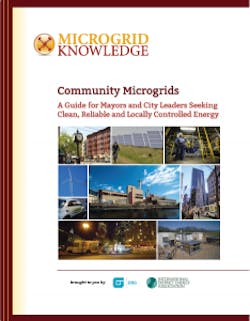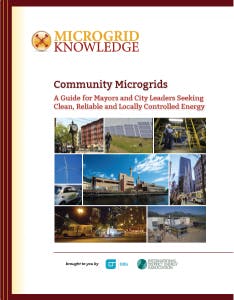Here are two more good reasons for community microgrids, excerpted from our new report, “Community Microgrids: A Guide for Mayors and City Leaders Seeking Clean, Reliable and Locally Controlled Energy.”
3. Microgrids can enhance community economics
Microgrids can strengthen community economics several ways — from attracting new businesses to reducing electricity rates.
Energy is a main input in pricing of most goods and services. Microgrids offer a means to help keep electricity rates in check through better grid management. This occurs in several ways.
First, good development practice dictates that buildings within a microgrid undergo cost-effective energy efficiency improvements. This reduces the need for power within the microgrid, so it cuts back on fuel and other generation-related costs.
Second, some microgrids are designed to serve areas of the grid experiencing an overload. The microgrid may offer a less costly solution than construction of new substations or transmission and distribution lines. Several of these ‘non-wire alternative’ microgrids are now being planned in New York.
In addition, advanced controllers and software allow microgrids to operate in a highly efficient—and therefore cost-effective manner. Many community microgrids also make use of valuable heat discarded and wasted in conventional power plants, which improves their economics and bankability.
Last, by easing energy costs, microgrids offer cities and towns competitive advantage in attracting industry and jobs.
It’s important to note that the presence and proximity of a community microgrid also can help draw industries that are sensitive to power outages, such as data centers, research facilities, pharmaceutical manufacturers and other high tech industries. These industries seek what is known as five ‘nines’ electricity, meaning that power is available 99.999 percent of the time. Cities and towns that offer that level of reliability will find themselves better positioned to compete when these highly sought-after businesses are seeking a new location.
4. Community microgrids improve the environment
Foster renewable energy
Many cities are attempting to incorporate renewable energy into their energy mix. Some have set specific goals. Phoenix, for example, intends to make renewable energy 15 percent of its mix by 2025. Some are even striving to become 100 percent renewable—and succeeding. The town of Greensburg, Kansas, now gets all of its electricity from renewables after being rebuilt following its almost total destruction from a tornado in 2007.
Microgrids can help these cities more easily incorporate renewable energy in two ways.
First, many microgrids include renewables, in particular solar, which has become increasingly appealing because of its falling costs and low carbon footprint.
There is a downside to solar and other forms of renewable energy; they can’t always be counted on to produce energy. The sun doesn’t always shine and the wind doesn’t always blow. But microgrids with advanced controllers and more than one generation source can accommodate this variability; they are able to select the best mix of resources—without human intervention. Based on weather forecasting and other factors, the microgrid selects and uses the mix of generation that works best at any given time.
Microgrids also can play a role in assisting the larger grid with its integration of renewable generation. The microgrid can act as a backup resource on the grid when solar and wind farms do not produce power. And as demonstrated at the Princeton University microgrid, a natural gas turbine generator can react and respond quickly to an unforeseen voltage sag caused by a dense cloud passing over a 4.5 MW solar farm.
Help cities meet climate goals
Climate change is a growing concern among municipal leaders, especially those who are along the coasts or who have experienced recent severe weather. Some cities have set greenhouse gas reduction goals.
Boston, for example, is striving to reduce greenhouse gas emissions 25 percent by 2020 and 80 percent by 2050, mirroring a mandate the state of Massachusetts has set for itself. As part of its plan, the city is encouraging development of more microgrids that use CHP and district energy. These would add to the city’s district energy networks operated by Veolia, which serve about 250 commercial and government buildings, hospitals, universities and other institutions. The network spans 45 million square feet in Boston and the Longwood Medical Area as well as the biotechnology corridor of Cambridge.
More cities are expected to do the same, as a way to help their states develop strategies that will be required under the Environmental Protection Agency’s pending Clean Power Plan.
Interestingly, in trying to achieve these goals, cities may also reduce their electric rates, if they pursue a systems approach that incorporates CHP connected to microgrids. That’s one idea explored in a new report, “Smart Tools in a 111(d) Toolbox: Combined Heat and Power (CHP) and District Energy.”
“District energy and CHP, coupled together, offer buildings an incredibly flexible and cost-effective local solution to meet onsite energy needs, while also providing considerable emissions reduction benefits,” said report author, Anna Chittum, Manager, Strategic Initiatives at the International District Energy Association (IDEA).
As the reports notes, CHP and DE could be excellent compliance options for states.
“CHP systems have always offered a way to do more with a single fuel input, offering a greater ‘bang for the buck’ while simultaneously reducing emissions intensity. They utilize much more of the useful energy of their fuels, often more than twice as much. In other words, they burn far less fuel to supply the same amount of energy, making their energy inherently less emissions-intensive.”
Given these four good reasons to build community microgrids — electric reliability, grid strengthening, economic advantage, and environmental improvement — likely to soon see many more microgrids in U.S. cities and towns. But how will communities pay for these microgrids? We survey the options in the next article in this series.
To read the rest of this article series now, go to “Community Microgrids: A Guide for Mayors and City Leaders Seeking Clean, Reliable and Locally Controlled Energy,” available as a free download, courtesy of the International District Energy Association (IDEA) and OBG. Or visit MicrogridKnowledge.com next week.
Note: This is the fourth article in our series on community microgrids. See our first three articles:
About the Author
Elisa Wood
Editor-in-Chief
Elisa Wood is the editor and founder of EnergyChangemakers.com. She is co-founder and former editor of Microgrid Knowledge.

